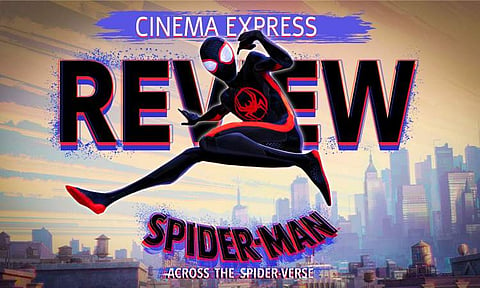

When Spider-Man: Into The Spider-Verse was released in 2018, the seismic impact of the film was so magnificent that it rippled across the animation industry for years afterwards and still continues to do so. By fusing art styles from hand-drawn to digital, and by playfully using classic comic book elements like panelling and typography, the animators created a daring animation style that brought fresh new energy to the industry. If that wasn’t impressive enough, the film had a well-written story, a focused creative vision, a deep understanding and respect for the Spider-Man mythos, and a killer soundtrack.
Sequels to such widely appreciated films usually crumble under the weight of expectations. The anxiety to go bigger in scale, faster in rhythm, and higher in stakes, are usually conspicuous in sequels. While Spider-Man: Across the Spider-Verse does strive to push past the scope and scale of the first film, it does so with meditative confidence. The film begins with an erratic pace and then towards the middle we find ourselves in moments of stillness where we could feel the story taking in a huge breath and exhaling slowly. These moments of calmness are carefully chosen to punctuate beautiful character moments, like when Miles Morales spends time with Gwen Stacey, when a frustrated Officer Morales shares his parenting woes with Spider-Man, or when Miles’ mom imparts heartfelt wisdom to her son. These are also the moments where we could sit back and let the visual splendour of the Spider-Verse arrest us with awe.
The first film was all about how Miles Morales deals with the expectations levied upon him. The second film goes a bit liberal with the number of themes it focuses on. It is about Miles learning to stand up for himself, Gwen longing to fit in, and fathers (Jeff Morales, Peter Parker, George Stacey, Miguel O'Hara) struggling to learn the complexities of parenthood. Even though every character goes through their own overarching journey and even though all of their stories are interestingly fleshed out, the web of themes, laid on top of each other, makes it an overwhelming experience to take it all in simultaneously. And on top of all of that, the central point of contention between Miles and the primary antagonist Miguel O'Hara (Oscar Issac) happens to be a variation of a trolley problem, where Miles is forced to decide between one life and a million others. While the use of such a philosophical quandary is not unusual for a superhero film, the exposition (Miguel O'Hara’s backstory) to explain why the villain takes the opposite stance to the hero sounds all too familiar. However, the film wins us over by showing us Miles’ wonderful character evolution and how he builds up the resolve and confidence to stand up for what he believes in.
At a crucial point in the film, after outsmarting almost a hundred other Spider-Man variants, Miles says to Miguel, “Everyone keeps telling me how my story is supposed to go. Nah, Imma do my own thing.” The brilliance of the film is in how that line could have easily come off as a typical punch-line. Instead, Miles delivers that line with a beautiful blend that goes from inner turmoil, self-doubt, disappointment at being betrayed, to confidence, unshakeable resolve, and unstoppable will. Moments like these tell us that the sublimity of a great performance could be captured through the hands of an artist tracing a line as much as the eyes of a performer. If there ever was a debate about animation being any less of an art form than live-action films then the Spider-Verse films echo as a resounding laughter on the face of such a question.
Whenever Hollywood is fascinated by an idea, it milks it dry until the shrivelled-up corpse of the idea is then repurposed to create parodies. You can see decades dotted with the rise and fall of ideas on films like time travel, simulation theory, and fourth wall breaking. A recent idea to go through this cycle is the ‘multiverse’. In the past few years, the idea of multiple universes and “variations” of familiar characters, have been used in a number of superhero films in rapid succession. It is hard not to shirk the thought that maybe this idea is being used as a convenient tool to retcon stories, add cameos for marketing purposes, recast actors without disturbing the ongoing storyline, and even erase entire lists of films that the studio executives are embarrassed about. What started out as a fun idea has become a shallow corporate tool to sell more content. Across the Spider-Verse is inundated with loads of cameos and callbacks to earlier films, you could hear the pre-programmed cheers already surging up when these moments have barely registered on screen. Despite all of that, it is undeniable that this film has exploited the ‘multiverse’ concept better than almost any other superhero film so far. You could see that by stripping away the cameos, references, and even the fact that it is a Spider-Man film. This could just be a story about a kid called Miles Morales who goes on an interdimensional adventure and it still holds up as a solid film with a lot of heart. And that’s how Across the Spider-Verse wins us over.